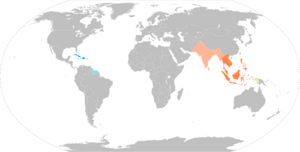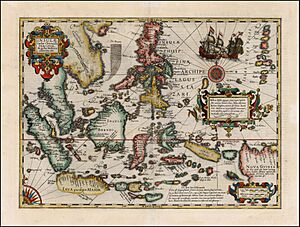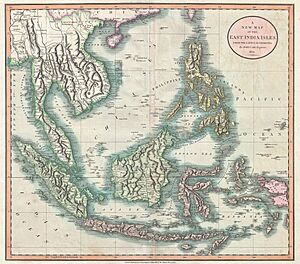East Indies facts for kids

The East Indies is a historical name for lands in the Eastern Hemisphere. This term was used a lot during the Age of Discovery, when European explorers were finding new sea routes. It mainly referred to the islands and mainlands around the Indian Ocean.
In a more specific way, the East Indies often means the Malay Archipelago. This area today includes countries like the Philippines, Indonesia, Borneo, and New Guinea. In the past, it also included the coasts of the Indian subcontinent and the Indochinese Peninsula.
What are the East Indies?
During the time of European colonization, many parts of the East Indies became colonies. For example, the Spanish Empire ruled the Philippines for over 300 years. This area was known as the Spanish East Indies.
The Dutch Empire also had many colonies in the region. These were called the Dutch East Indies for about 300 years, until Indonesia became independent. Other parts of the East Indies included areas once ruled by France, Britain, and Portugal. This means places like former French Indochina, Brunei, Hong Kong, Singapore, Portuguese Macau, and Timor.
It's important to know that people from the East Indies are not called "East Indians." This is because they are not related to people from South Asia (like India) in terms of language or background. This helps avoid confusion with people from the Caribbean, who are sometimes called "West Indians," or indigenous peoples of the Americas, who are often called "American Indians."
The people of the East Indies have many different cultures. They do not see themselves as one single group. Most people in the region are Austronesians. They originally came from the island of Taiwan. Later, people from East Asia, like the Han Chinese, moved south. They became known as the Peranakans or Straits Chinese.
Many different religions are practiced here. These include Buddhism, Christianity, Islam, and Hinduism. Other beliefs like Sikhism, Jainism, and Chinese folk religion are also found. The main languages come from families like Austronesian and Sino-Tibetan languages. These are different from the Indo-Aryan languages spoken in the Indian subcontinent.
Sometimes, parts of the East Indies are named after the European country that once ruled them. For example:
- Spanish East Indies usually means the Philippines.
- Dutch East Indies refers to Indonesia.
- British East Indies often means Malaysia.
History of the East Indies

European countries began exploring the East Indies in the late 1400s. The Portuguese explorers were among the first. They called the entire region they found the "Indies."
Over time, the "Indies" were split into two main parts:
- The East Indies, also called "Old Indies" or "Great Indies," which included India and Southeast Asia.
- The West Indies, also called "New Indies" or "Little Indies," which referred to the Americas.
These regions were very important for trade. European companies like the British East India Company and Dutch East India Company were set up in the 1600s. They traded goods like cotton, indigo, and valuable spices from the East Indies.
When Christopher Columbus sailed west from Europe, he thought he had reached the eastern part of the "Indies." He didn't realize there was a whole new continent in the way! To avoid confusion, the newly discovered lands in the Americas became known as the "West Indies." The original lands in Asia then became known as the "East Indies."
The name "East Indian" was once used to describe people from all over the East Indies. This helped to tell them apart from the American Indians, who were also often called "Indians."
See also
 In Spanish: Indias Orientales para niños
In Spanish: Indias Orientales para niños
- Spanish East Indies
- Dutch East Indies
- List of governors of the Dutch East Indies
- Insulindia
- Portuguese East Indies
- French Indochina
- List of governors-general of the Philippines
- Global Southeast, largely coterminous with historic meaning of East Indies
- Greater Philippines
- Straits Settlements
- Malayness
- Bumiputera
- Pribumi
- Malay world
- Malay Archipelago
- Malay race
- Maphilindo
- Maritime Southeast Asia
- Nusantara
- Greater Indonesia
- History of the Americas



